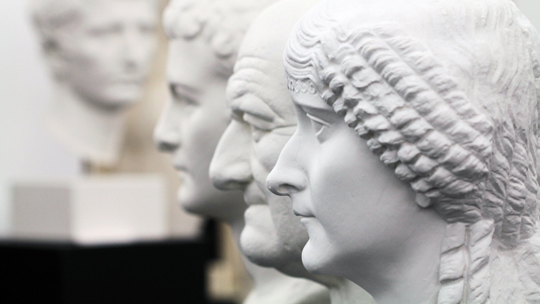Awakening from a deep sleep
Freiburg, Dec 04, 2017
Whether they are coins, minerals, mounted animals or brains sitting in formaldehyde: Universities have a myriad of collections, but oftentimes it is the lack of personnel and know-how to make them beneficial for teaching purposes. Starting December 2017 a conference by the association German U15, a consortium of 15 large German universities with strength in the area of research, is taking place in Berlin. The universities’ collections and their pedagogical potential are the focus of the meeting. Dr. Christian Wacker, training director for “museOn”, which focuses on modern museum work and Dr. Jens-Arne Dickmann, curator for the Archaeological Collection, will be representing the University of Freiburg. Eva Opitz asked Wacker what value the collections could have for teaching.

Workshop, not shop window: Together with students, Jens-Arne Dickmann works on exhibits that present the Archaeological Collection to the broader public. Photo: Manfred Zahn
Mr. Wacker, how did the collections at the universities come to be in the first place?
Christian Wacker: Traditionally, science has been the focus at old universities steeped in tradition: Professors who had an interest in a particular subject were in search of something new or peculiar. Instruction took a backseat. Today these collections are barely maintained. They have nostalgic value, but they aren’t suitable for modern museum work in their current form.
Does that mean the collections have no value to the universities today?
Not at all. The collections should be pulled out of their slumber as soon as possible. I am convinced that we would discover true treasures within them. But it is very expensive to use a collection for teaching or to make them visible in exhibitions. We don’t have the staff to maintain them and usually there is a lack of know-how as well. Those who watch over the collections are scientists, not museum experts. Unlike museums, universities typically don’t have the budget to obtain additional objects. If you wish to expand a collection, you have to rely on donations, sponsors or donor associations.
What role could collections play in teaching nonetheless?
A good example is the Archaeological Collection at the University of Freiburg. Its curator Dr. Jens-Arne Dickmann is going to present it as an example of best practice at the conference in Berlin. Together with the students, he develops concepts for exhibitions in order to make the collection publicly visible. He has the future archaeologists write catalogues and create the presentation. It is museum work in teaching. From it a true teaching collection can emerge.
Do you see this kind of potential in other collections too?
Of course. Every collection has value in and of itself within a certain context. For instance: After being taken over by the University, an approximately 100-year-old collection of folksong archives turned into the Center for Pop Culture and Music. From the lyrics, conclusions can be drawn on the everyday culture of the respective era - thereby creating an image of society over decades. Such collections should be integrated better in teaching.

University collections often have a tough time of it, says Christian Wacker: Oftentimes there aren’t enough trained staff to maintain them. As a rule, there also is no budget to obtain new objects. Photo: Jürgen Gocke
What happens to those collections that go unnoticed in cabinets or drawers?
The general recommendations for storing collections, as outlined by the International Council of Museums (ICOM), should be observed so that the objects don’t get damaged. It is a serious task, for example, to properly store paper and protect textiles and biological preparations such as mounted animals or beetle collections from moth infestations. After all, the collections are university property and thus common property for all of society.
What is there to do?
For starters, a large exhibit hall should be provided to the Uniseum, for instance. Faculties would certainly be more interested in engaging with collections, assessing their value for teaching purposes, and making them public if they had a large hall.
What do you hope to get out of the conference?
We will network with colleagues who are working on similar topics. Some of them have built up interdisciplinary networks that address university collections. We will also address collaborations between scientific collections with museums or municipal institutions. I think such collaborations are a good idea.

